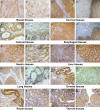Investigating the expression, effect and tumorigenic pathway of PADI2 in tumors
- PMID: 28331341
- PMCID: PMC5352236
- DOI: 10.2147/OTT.S92389
Investigating the expression, effect and tumorigenic pathway of PADI2 in tumors
Abstract
Background: Peptidylarginine deiminase (PAD) catalyzes the conversion of arginine residues to citrulline residues, termed citrullination. Recent studies have suggested that PAD isoform 2 (PADI2) plays an important role in tumors, although its tumorigenic effect and mechanism are largely unknown.
Materials and methods: Immunohistochemistry and enzyme-linked immunosorbent assay (ELISA) were used to investigate the expression level of PADI2 in various tumor tissues and patient blood samples, respectively. MNK-45 and Bel-7402 tumor cell lines originating from gastric and liver tumors, respectively, were treated with anti-PADI2 siRNA, and the subsequent cell proliferation, apoptosis and migration were observed. Polymerase chain reaction (PCR) arrays, including Cancer PathwayFinder, Oncogenes and Tumor Suppressor Genes, p53 Signaling Pathway, Signal Transduction Pathway and Tumor Metastasis PCR arrays, were used to investigate the tumorigenic pathway of PADI2 in the siRNA-treated tumor cells. This analysis was verified by real-time PCR.
Results: Immunohistochemistry detected significantly increased expression of PADI2 in invasive breast ductal carcinoma, cervical squamous cell carcinoma, colon adenocarcinoma, liver hepatocellular carcinoma, lung cancer, ovarian serous papillary adenocarcinoma and papillary thyroid carcinoma samples. ELISA detected a twofold increase in PADI2 expression in the blood of 48.3% of patients with liver cancer, 38% of patients with cervical carcinoma and 32% of patients with gastric carcinoma. Increased apoptosis and decreased cell proliferation and migration were observed in the anti-PADI2 siRNA-treated MNK-45 cells, and increased cell proliferation and migration and decreased apoptosis were observed in the treated Bel-7402 cells with suppressed PADI2 expression. PCR arrays and real-time PCR detected significantly decreased CXCR2 and EPO expression in the MNK-45 cells and Bel-7402 cells, respectively, with the anti-PADI2 siRNA treatments.
Conclusion: PADI2 expression is increased in many types of tumor tissues and patient blood samples. PADI2 may advance abnormal cell behavior in gastric cancers by mediating CXCR2, a well-known gene that stimulates cell proliferation and invasion. However, PADI2 might have deleterious effects on tumor growth and metastasis in liver tumor cells by regulating the expression of EPO, a gene with controversial functions in tumor growth. The results suggest that the effect of PADI2 on tumorigenesis is multifactorial, depending on the tumor type.
Keywords: CXCR2; EPO; PADI2; pathway; tumorigenesis.
Conflict of interest statement
Disclosure The authors report no conflicts of interest in this work.
Figures








Similar articles
-
PADI2 gene confers susceptibility to breast cancer and plays tumorigenic role via ACSL4, BINC3 and CA9 signaling.Cancer Cell Int. 2016 Jul 29;16:61. doi: 10.1186/s12935-016-0335-0. eCollection 2016. Cancer Cell Int. 2016. PMID: 27478411 Free PMC article.
-
PADI4 has genetic susceptibility to gastric carcinoma and upregulates CXCR2, KRT14 and TNF-α expression levels.Oncotarget. 2016 Sep 20;7(38):62159-62176. doi: 10.18632/oncotarget.11398. Oncotarget. 2016. PMID: 27556695 Free PMC article.
-
Protein-arginine deiminase 2 suppresses proliferation of colon cancer cells through protein citrullination.Cancer Sci. 2017 Apr;108(4):713-718. doi: 10.1111/cas.13179. Epub 2017 Apr 12. Cancer Sci. 2017. PMID: 28403548 Free PMC article.
-
Identification of PADI2 as a potential breast cancer biomarker and therapeutic target.BMC Cancer. 2012 Oct 30;12:500. doi: 10.1186/1471-2407-12-500. BMC Cancer. 2012. PMID: 23110523 Free PMC article.
-
Increased PADI4 expression in blood and tissues of patients with malignant tumors.BMC Cancer. 2009 Jan 30;9:40. doi: 10.1186/1471-2407-9-40. BMC Cancer. 2009. PMID: 19183436 Free PMC article.
Cited by
-
Post-Translational Protein Deimination Signatures in Plasma and Plasma EVs of Reindeer (Rangifer tarandus).Biology (Basel). 2021 Mar 13;10(3):222. doi: 10.3390/biology10030222. Biology (Basel). 2021. PMID: 33805829 Free PMC article.
-
Peptidylarginine Deiminase IV Regulates Breast Cancer Stem Cells via a Novel Tumor Cell-Autonomous Suppressor Role.Cancer Res. 2020 Jun 1;80(11):2125-2137. doi: 10.1158/0008-5472.CAN-19-3018. Epub 2020 Apr 7. Cancer Res. 2020. PMID: 32265227 Free PMC article.
-
Accumulation of citrullinated glial fibrillary acidic protein in a mouse model of bile duct ligation-induced hepatic fibrosis.PLoS One. 2018 Aug 2;13(8):e0201744. doi: 10.1371/journal.pone.0201744. eCollection 2018. PLoS One. 2018. PMID: 30071078 Free PMC article.
-
Integrating proteomics and transcriptomics for the identification of potential targets in early colorectal cancer.Int J Oncol. 2019 Aug;55(2):439-450. doi: 10.3892/ijo.2019.4833. Epub 2019 Jun 27. Int J Oncol. 2019. PMID: 31268166 Free PMC article.
-
Evolutionary analysis reveals the role of a non-catalytic domain of peptidyl arginine deiminase 2 in transcriptional regulation.iScience. 2024 Mar 27;27(4):109584. doi: 10.1016/j.isci.2024.109584. eCollection 2024 Apr 19. iScience. 2024. PMID: 38623337 Free PMC article.
References
-
- Pritzker LB, Nguyen TA, Moscarello MA. The developmental expression and activity of peptidylarginine deiminase in the mouse. Neurosci Lett. 1999;266(3):161–164. - PubMed
-
- Arita K, Hashimoto H, Shimizu T, Nakashima K, Yamada M, Sato M. Structural basis for Ca(2+)-induced activation of human PAD4. Nat Struct Mol Biol. 2004;11(8):777–783. - PubMed
-
- Chavanas S, Méchin MC, Nachat R, et al. Peptidylarginine deiminases and deimination in biology and pathology: relevance to skin homeostasis. J Dermatol Sci. 2006;44(2):63–72. - PubMed
LinkOut - more resources
Full Text Sources
Other Literature Sources
Research Materials
Miscellaneous

